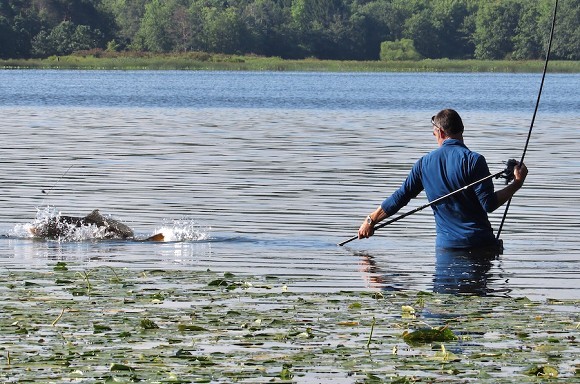
Carp Letter from America - July
Our bloggers in America, Simon Blanford and Andy Bell, tell us what they got up to in July...
Early in the morning one late June day Andy received a telephone call from the old country.
CARPology HQ: Hello, Andy?
Andy: (Groggily) Yea?
CARPology HQ: Hi, it’s CARPology headquarters here.
Andy: Who?
CARPology HQ: CARPology headquarters. Listen..
Andy: Do you know what time it is here?
Mrs Andy: Andy - what’s going on? Has your aunty’s dachshund died again?
Andy: No love, don’t worry it’s some idiot from CARPology. Go back to sleep.
CARPology HQ: None of that lip sonny. Seen the news? Some geezer’s gone and caught a new State record in your neck of the woods. 53lb! Bloody good fish. Bloody good effort! And what are you doing? Still tucked up in bed with Mrs Andy! Where’s the effort? Where’s the commitment? Here we are giving you all this money and space on…
Andy: What money?
CARPology HQ: …all this space on our website and all you’ve got to offer is a bloody 35! We don’t want 35s. Ten-a-penny at Gigantica. We want outsize wild fish nobody has ever seen before - and you were meant to supply them! Now where’s the bleedin’ climax to your ponsy ‘Carp Letter from America’? Tell me that!
Andy: Well, listen, ……….. it’s Simon’s fault really. If he hadn’t….
The conversation went on in this vein for some considerable time. And it’s true a new State record has been caught in our neck of the woods. And we are delighted to see the decades old record beaten. No, really, we are. Really. We are because it demonstrates that fish of this caliber are out there. After all it’s one thing to see hazy newspaper cuttings of fifty pound plus fish and quite another to actually see crisp photos of such a beast.
Of course we went to the river the record had been hauled from. It was on our ‘to-do’ list anyway - a great winding ribbon meandering through the heart of the State, a river with the reputation of holding very big fish. When we arrived we had a good scout round and debated where to fish. Summer has been wet here in the north-east. Rivers have gone up, stayed up and then gone up a little more. This river, we shall call it the Big River, was also up and murky, a powerful flood of water muscling along between its banks. The elevated surface and cappuccino colour masked many features but we eventually settled for an area of slacker water that looked like it might hold some fish sheltering from the main push. It did and we caught them. But they were the wrong type.
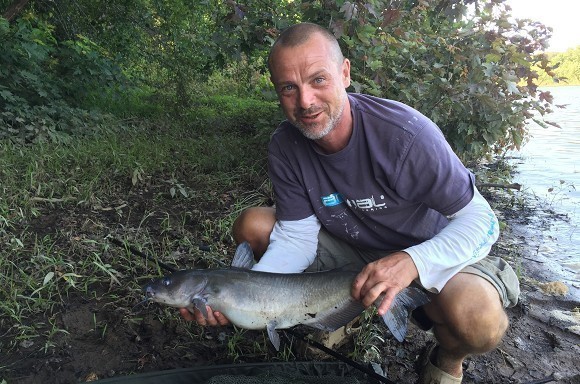
Andy holds the wrong type of fish.
So we decided to can the rivers until there had been a spell of settled weather long enough to allow levels to fall to something more reasonable. In the meantime Andy nipped off for a session at The Lake full of expectation following last month’s catches. He eschewed the company of Simon and instead took The Neighbour: a dedicated drinker but only a casual fisherman and a carp virgin. Andy caught an eleven pounder. The Neighbour landed two twenties. The Lake it seems has a sense of humour.
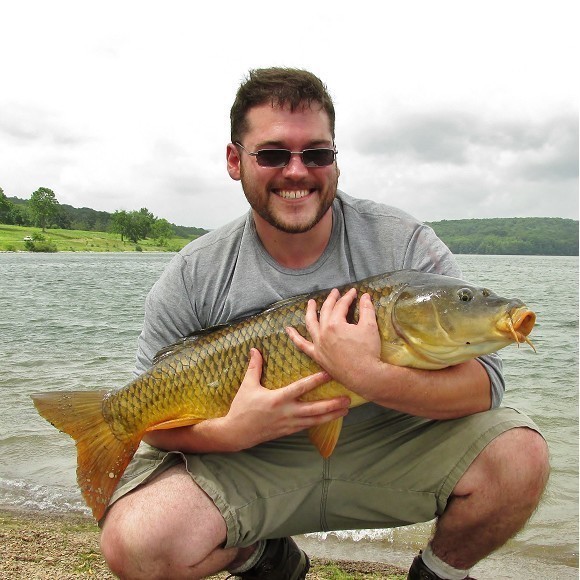
The Neighbour – no longer a carp virgin.
Andy, goaded by the result forced Simon from the bosom of his family for a return. We caught nine fish one of them breaking the twenty pound barrier.
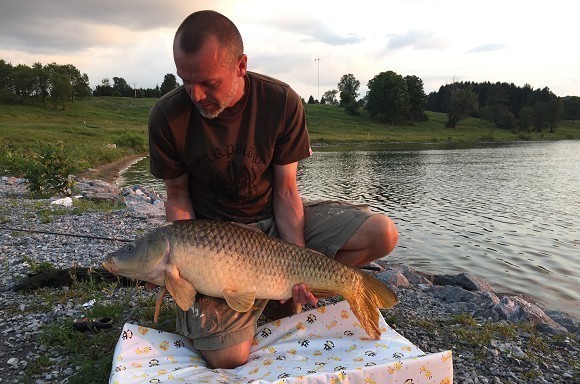
Another twenty from The Lake
The Lake was really producing and it would have made sense to milk this good run for all it was worth. Instead we went somewhere else.
Locals had been telling us that The Other Lake, was better than The Lake. Quite. To have an initial look round and get a feel for the place we went en famille, as the Russians say, accompanied by Mrs Andy, Mrs Simon and Miss Simon 1 and 2. We’d do the family stuff until late afternoon and then the females would leave in one car and we’d stay to fish through the night. It was immediately apparent that there were plenty of fish around and after a tour of the lake, a picnic and a bit of a swim Andy and Simon bade adieu to the women and hurried to their chosen swim.
It was taken by a garrulous bloke fishing for pike. He said he’d be off in ten minutes or so and we waited at his side listening to an endless stream of, what might only very generously be called, consciousness. His pike outfits (three of them laid out on the grassy bank) were an eclectic mix of rods and reels. Bite indication was not immediately apparent. On the hook he was using, and the evidence was there in a plastic container next to his rods, Chinese style breaded chicken fresh from the nearest takeaway. As he talked we noticed the line on his middle rod veering to the left. We brought it to his attention, he having turned bodily towards us so as to give us his undivided attention. He seemed not particularly animated by this fact and it wasn’t until we suggested he pick up his rod and do something that he did. The line broke almost as soon as he had tightened and it turned out, by his own unabashed admission, that he was fishing single hooks, no trace and two pound line. “Must have been a darn big pike,” he claimed though how he could have known this rather than the culprit being a catfish, snapping turtle or a particularly hungry, and somewhat aquatic local with a desire for damp oriental provender, we couldn’t figure out. Anyway, the idea of using line and tackle of appropriate strength, of employing a sensitive form of bite indication, or of striking quickly to avoid deep hooking, never appeared to have occurred to him. It was after all, only a fish and really, who cares about the welfare of a sodding fish?
This subject, that of fish welfare, is one of the main differences between this and your side of the pond. Much of the American fishing scene is still concerned with catching something to eat. Fishing for meat likely imposes quite a different sensibility on the angler than does fishing purely for the joy of capture. But even if you are fishing for food a lot of the catch is undersized or undesirable in some way and thus is thrown back. Literally thrown of course and, as it goes here, that is considered pretty good handling practice. We noticed this recently when fishing The Lake. An angler a little way down the bank hooked and landed a pike. Not a big one, what might be called a ‘jack’. He was clearly delighted by the capture though and so reeled the fish up to the tip of his prodigiously bent rod, swung it onto the tarmac path behind him and then he stood on it to keep the animal still while he ripped out the hooks. He did return it, throwing it down the five foot bank to land with, what must have been for him, a satisfying splash.
Despite this episode pike and muskies are often released now, even if the handling and unhooking methods are still somewhat barbarous. Carp on the other hand have no saving graces in the eyes of many American anglers and we find the evidence of this ambivalence in places like the bankside vegetation.
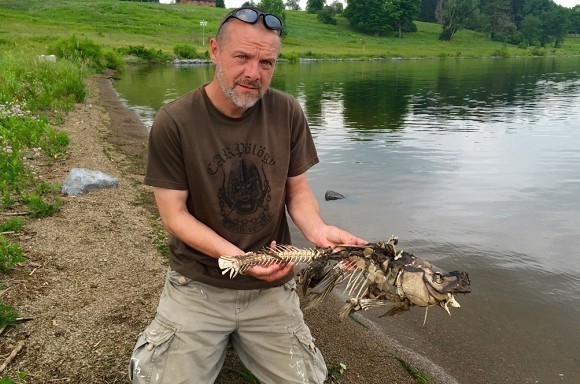
Seen better days.
Or even more pointed indications of some anglers’ dislike of the fish.
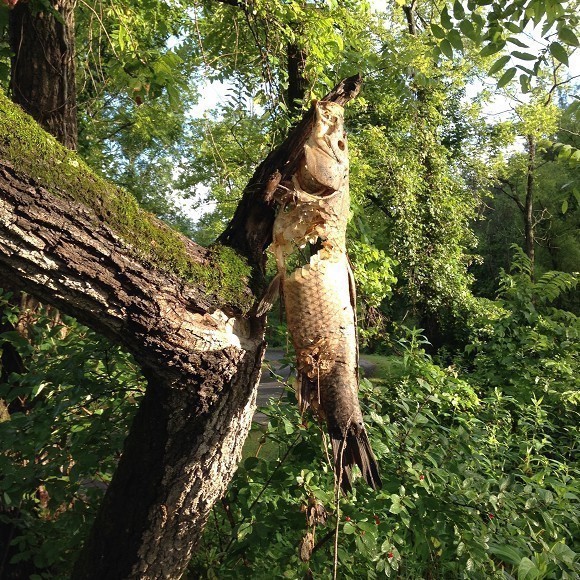
Strange fruit
Antipathy towards the fish is deep-seated in some and if by no means a general attitude (apathy would be closer to the mark for carp), it does allow the ‘sport’ of bowfishing to continue unquestioned. In fact much of our initial interactions with other bankside folks is to disabuse them of the fact that just because we are after carp doesn’t automatically make us bowfishers. This was clear when Simon roped in a couple of young lads to take some photos of the big fish from last month. The youngsters immediately assumed he was bowfishing on being told carp were his target and peered at Simon’s rod pod as if trying to decipher what sort of novel, high-tech archery rig this was. In fact here it is the carp angler rather than bowfisher who often feels as though they have something shameful to admit: “I am a carp angler” one might say, “it has been five days and three hours since my last session.”
Bowfishing is, of course, rather terminal for the carp (have a sortie on YouTube for some graphic evidence if you like). Shot with an arrow attached to a length of braided line they are then reeled in and gaffed. They may subsequently be given the coup de grâce once on board the boat but are just as likely to be chucked into a plastic bin to flop and flap their last. On shore some are ploughed into the ground as fertiliser but many are simply dumped. None are eaten it seems, the whole justification for most hunting. While the process may raise hackles in the UK it is just part of the normal outdoor scene here. After all, many see carp as nothing more than a cold-bloodied, slimy, invasive fish that ruin the water for other more desirable species. The term “trash fish” may well have been coined specifically for carp.
Now all that said it also has to be realised that bowfishing, while it may have local impacts on certain waters, has very little broader effect on carp and their numbers. And it’s not as though American anglers can’t become interested in the fish. Much of the innate prejudice is simply ignorance - an attitude to the fish handed down without any real knowledge of the animal itself. And there is already a minority who do fish for carp UK style and advocate for their inclusion as a game fish worthy of attention.
Brian Wingard for example, a dedicated carp head from Pennsylvania and Trakker pro on this side of the pond, has been involved in trying to get anglers and those that look after the public’s angling interests, to take carp more seriously. For some years he has been working with Pennsylvania’s fish and boat commission (the body that controls and oversees fishing in the State) as part of a carp study group to increase protection and improve carp fishing. As a result various fishing rules have been amended in favour of carp anglers and Pennsylvania even has a clickable map that shows the ‘best’ lakes for large carp. The map is a worthy output but also, in its early form, a rudimentary and incomplete tool - a very small drop in the ocean of the American fishing scene. Mind you, that can be seen as a good thing. America is undoubtedly a carp haven and possibly the last great bastion of accessible yet almost untouched carping for wild fish left on the planet. So, you lot across the water there, stay away would you. That’s the ticket, good chaps, jolly good show.
Back to our first session at The Other Lake. Once the verbal angler had left we hustled into the swim and set out our stalls. Just as we were almost set up the forecast rains appeared in the form of a spectacular thunderstorm. We retired to shelter under the tailgate of the car waiting for it to dissipate. It didn’t so we went out to fish anyway. Just before dark and in a lull in the storm we landed a nice eighteen pounder and noticed fish patrolling the margins. It was looking all set for a good night if the rain would only stop. But the rain didn’t stop. It fell even harder and continued to do so throughout the night. The next thing we noticed was the water rising and colouring as the creek feeding the bay we were fishing disgorged its swollen flood water into the lake. Wet, cold, disgruntled and feeling that the fish we had seen moving before the deluge had been pushed out of the bay by the influx of cool and dirty water Simon retired at three in the morning to the car for some warmth and a kip. Andy soldiered on sitting sodden on his picnic chair, groundsheet draped over him as the bank behind him eroded into the lake. By five we’d had enough, photographed Simon’s sacked fish and took a drive round the lake to look for a less saturated swim.
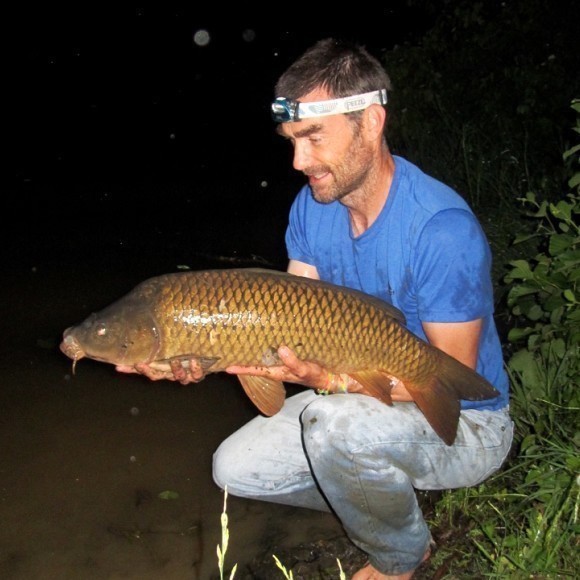
Aprčs le deluge we photographed the only fish caught that night.
Naturally the next day dawned bright, clear and warm. We were knackered so plumped for a comfortable grassy spot and laid out what sodden kit and clothing we could to dry in the morning sun. Noticing a fish patrolling the margins we each fished one rod short and the others out into the middle of the bay. As with many of these lakes there is prolific weed growth during the summer. The bottom, at least to a certain depth, becomes covered with a savannah of aquatic plants. We were too exhausted to sort out good placement of our end tackle and rather by luck than judgement we had one run (lost) and one fish to Andy on the long rods out in the weed. The margin rods picked up a further three fish all being mid-doubles to about seventeen pounds. Clearly The Other Lake had potential but to what extent this potential might translate into truly big fish wasn’t clear. What was clear was that we would soon be back.
Two weeks later we had booked a shore-side cabin and installed ourselves. Unfortunately Mrs Andy couldn’t make it as she was afflicted by work, that curse of the modern layabout. But Mrs Simon and the two Miss Simon’s came for the three-day stay. The cabin was cheap, soundly built, warm, watertight and all in all a perfect base from which to stroll down the mere twenty yards or so of close cropped grass to the lake. Our swim looked out over the opening of a delightful bay. Immediately in front of us was a bed of lily pads extending fifteen yards or so out into the lake broken only by a narrow central channel of lily-free water. We would have to fish over these pads and find a way of bringing anything we hooked through them. We were prepared for the submerged weeds we expected to find having exhumed the Dredgernaught (see May’s article) and brought along snorkel and mask for a closer inspection.
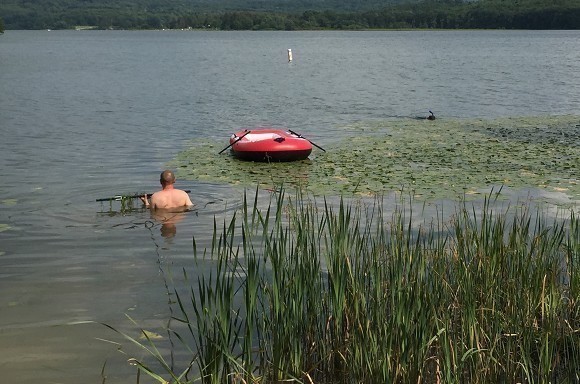
Andy wields the dredgernaught while Simon pretends to do some serious aquatic surveying.
What this revealed was there was simply too much weed for the dredgernaught to have any real impact. But further out as the bottom shelved down into the bay the weed grew less tall, stuttered and eventually petered out altogether in about fifteen feet of water. This was good as the clear bottom was within easy casting range. But it was also slightly disconcerting as swimming down to check out the bottom we clearly crossed a thermocline separating the balmy water that stretched eight or so feet down from the surface from the decidedly chillier water closer to the bed of the lake. We couldn’t measure what this temperature difference was and so wondered whether the carp would make much effort to cross what felt like a stark thermal divide and feed on any bait we put down in the cooler depths. We didn’t have much choice though as clearing enough space in the rampant weeds closer to shore would have taken considerable effort. So we sowed the deeper, clearer, cooler water with our seed and crumb mix and fished with just one rod investigating the patchily vegetated margins. Hookbaits were our standard corn popped-up over a bed of mixed corn, chipped corn, wheat and a few other miscellaneous seeds bound together with breadcrumb. Nothing happened until the following day when Andy was into a fish that headed straight for the right hand lilies and tied itself up so thoroughly that by the time Simon had the boat out the fish had long gone.
We widened the channel through the pads a little but eventually found it easier to walk left or right through the margins to reach the edge of the pads and steer fish safely into the net.
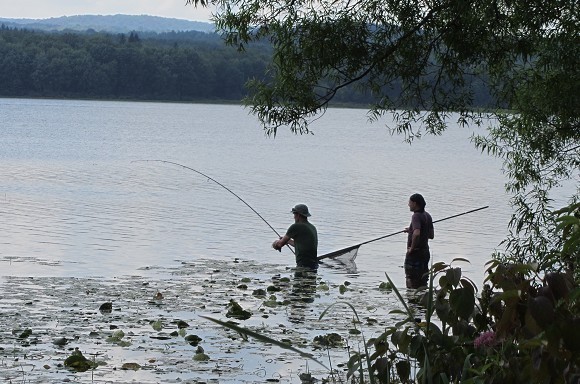
Walking out to the edge of the lily pads proved a better method of getting fish on the bank.
And on the second day the fish began to come starting with two smaller fish before an eighteen and a twenty showed up giving Mrs Simon the rare opportunity of getting both Simon and Andy in the frame at the same time.
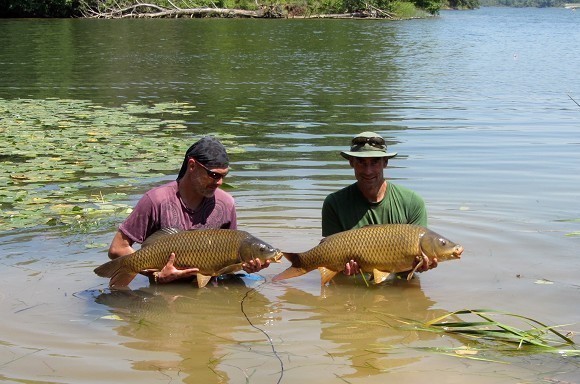
The quality of the fish is apparent - likely never touched, never caught before.
Throughout the next two days fish, small ones of six or seven pounds through to low twenties, came to our baits, never in a steady stream and never in any really discernible pattern but they came in fits and spurts nevertheless.
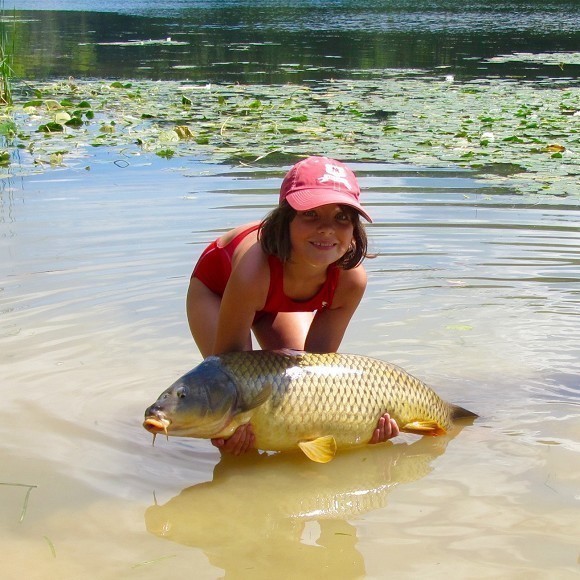
Miss Simon No. 1 holding one of the twenties.
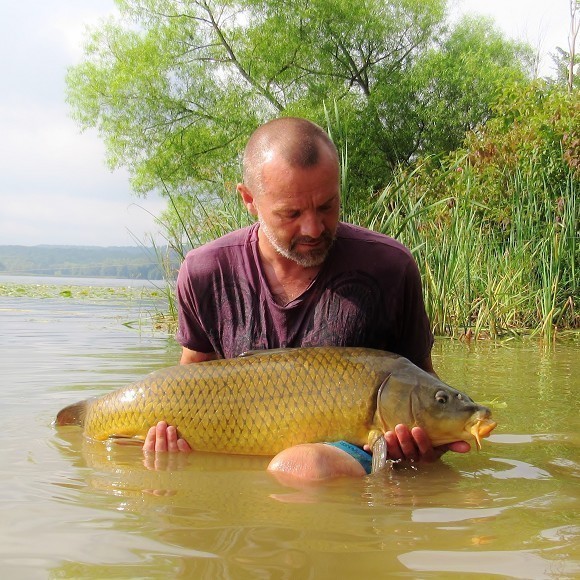
Another perfect common.
The bright afternoons were slow going and while Simon helped entertain the Miss Simons, Andy retired to his chair to catch up on some reading.
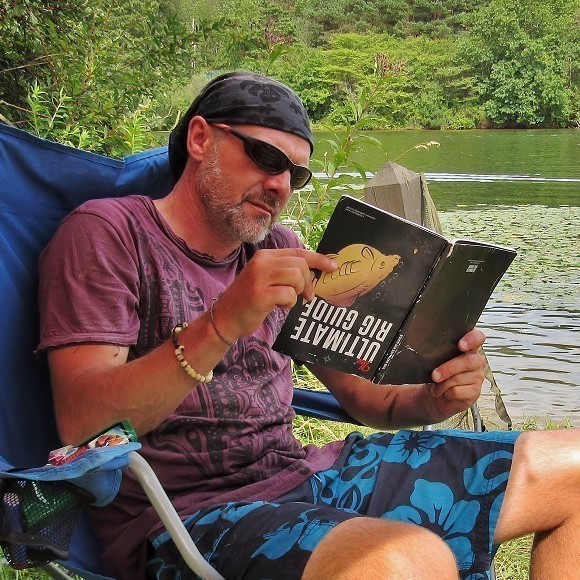
Slow afternoons allowed us to try and master CARPology’s rig guide.
Night time was a blow out at least on the first and last night and so we talked around the campfire.
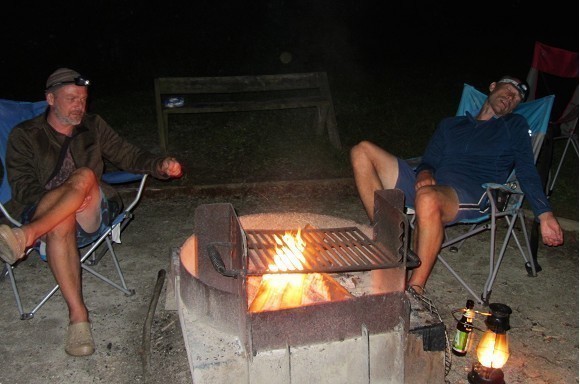
Andy enters the third hour extolling the relative virtues of the palomar and the tucked half blood knots.
In between Andy braved thunder and lightening to take another twenty, which he sacked for the morning and then wrestled with to try and get it to pose for the cameras.
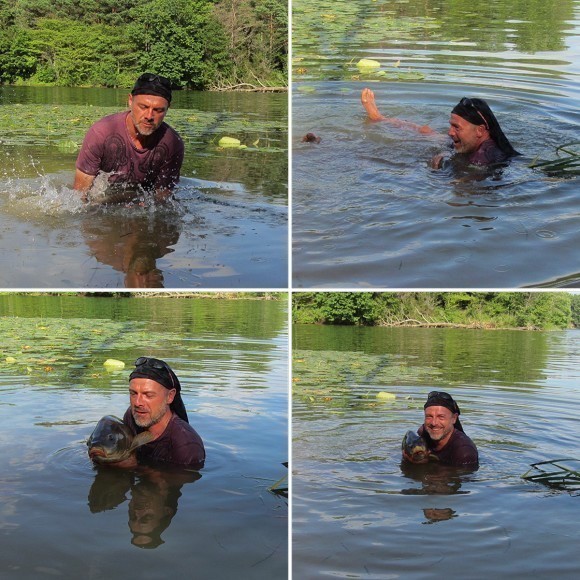
A recovered nighttime caught fish can be a handful when asked to pose for the camera the following morning.
By the start of our last morning we had banked twelve fish between about six and twenty-one pounds, four of which had been twenties and another three between eighteen and twenty. We had to decamp by ten on the last morning and so were up early to squeeze out the last bit of fishing we possibly could on a beautiful misty morning.
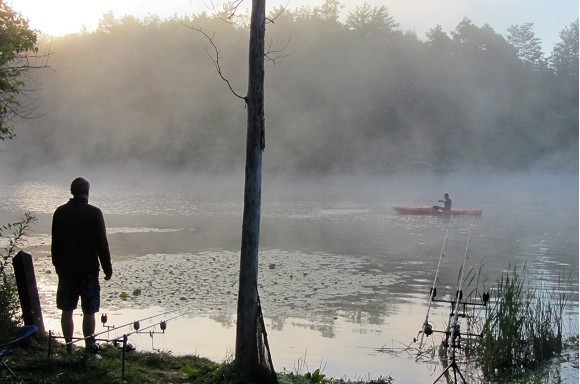
Getting the bait in on our last morning.
And it paid off with seven fish coming rapidly to our rods in the last couple of hours, topped by the largest fish of the stay at twenty-four pounds.
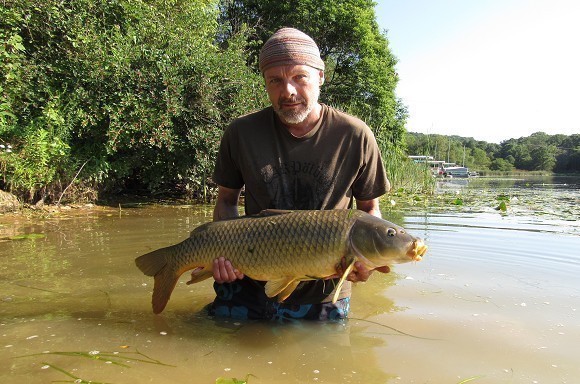
A final morning fish.
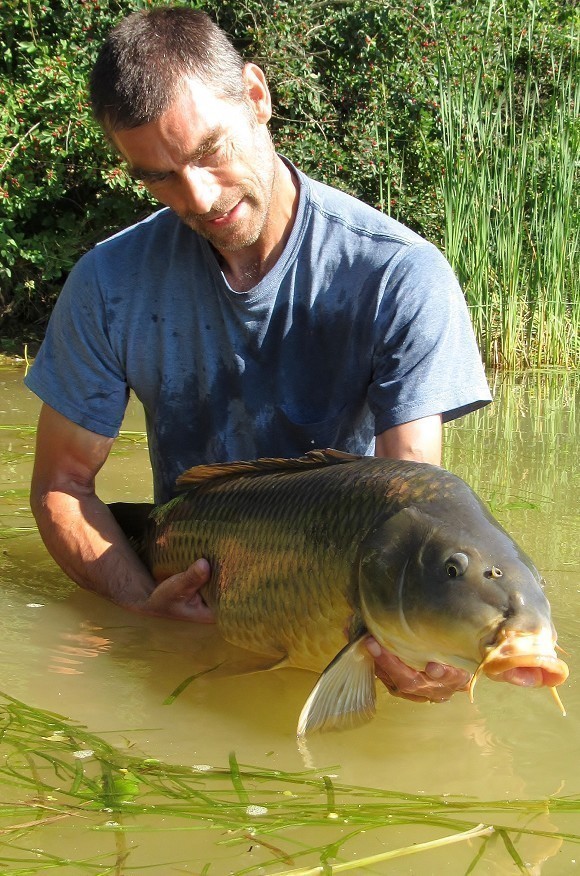
A mid-twenty to round off the trip
The Other Lake did prove to be a great venue. When you can couple the fishing with a snug cabin and comfortable beds right next to the swim it becomes even more attractive. How large these carp grow we don’t know but the regularity with which fish in the upper doubles and low to mid twenties came to the net suggests there may well be something considerably bigger to be caught. Camping is popular in the U.S. though and these cabins wouldn’t be available again until September. So it was back to the maps searching for accessible swims in the waters we already knew and looking for new waters to test. And we found one, a new lake, The New Lake. It had deep water, islands, shallows, mud flats, lots of nice weed in which the carp could be seen gurgling and sucking at whatever it is carp gurgle and suck at. We decided to make a visit to the New Lake. We’ll tell you about it next month.




